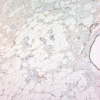Immunohistochemical evaluation of hormone receptors with predictive value in mammary carcinomas
- PMID: 24778819
- PMCID: PMC3945246
Immunohistochemical evaluation of hormone receptors with predictive value in mammary carcinomas
Abstract
AIMS. Immunohistochemical evaluation of hormone receptors (ER, PR) and correlation of immunohistochemical and morpho-clinical data. METHOD. The study was performed on paraffin-embedded and HE stained tissues originating from 100 cases of invasive mammary carcinoma. Monoclonal antibodies anti-estrogen and anti progesterone receptors were used for the immunohistochemical study. The detection system was EnVision HRP and the visualization system was 3-3' diaminobenzidine tetrahydrochloride (DAB). The evaluation of the result was performed using the Allred score. REZULTS. The majority of the studied cases (57%) expressed both types of hormone receptors and in 32% of the cases the hormone receptors were completely absent. The rest of the cases presented a heterogeneous phenotype: 7% presented the ER-/PR+ type and 4%, the ER+/PR- type. Compared with the classical phenotype (ER+/PR-), ER+/PR- tumors were more frequent at patients over 50 years. The tumors with ER+/PR- were larger than the ER+/PR+ and they were of the invasive ductal carcinoma type with an Allred score for ER under 6. CONCLUSION. The predictive value is amplified when the ER status is correlated with the PR status because the heterogeneous phenotypes are identified, especially the ER+/PR- phenotype which have an aggressive behavior and the lowest response to tamoxifen therapy.
Keywords: hormone receptors; immunohistochemistry; mammary carcinoma; predictive factors.
Figures










Similar articles
-
Immunohistochemical evaluation of hormone receptors with predictive value in mammary carcinomas.Rom J Morphol Embryol. 2011;52(4):1331-6. Rom J Morphol Embryol. 2011. PMID: 22203942
-
Evaluation of Immunohistochemical Profile of Breast Cancer for Prognostics and Therapeutic Use.Niger J Surg. 2018 Jul-Dec;24(2):100-106. doi: 10.4103/njs.NJS_2_18. Niger J Surg. 2018. PMID: 30283220 Free PMC article.
-
Ductal invasive mammary carcinoma--clinicopathological prognostic factors related to immunohistochemical expression of hormonal receptors and Her2/neu oncoprotein.Rom J Morphol Embryol. 2011;52(3 Suppl):1059-64. Rom J Morphol Embryol. 2011. PMID: 22119825
-
Hormone receptors in breast cancer: An update on the uncommon subtypes.Pathol Res Pract. 2023 Oct;250:154791. doi: 10.1016/j.prp.2023.154791. Epub 2023 Sep 3. Pathol Res Pract. 2023. PMID: 37672851 Review.
-
Estrogen and progesterone receptor expression is not always specific for mammary and gynecologic carcinomas: a tissue microarray and pooled literature review study.Appl Immunohistochem Mol Morphol. 2009 Oct;17(5):393-402. doi: 10.1097/PAI.0b013e31819faa07. Appl Immunohistochem Mol Morphol. 2009. PMID: 19417624 Review.
Cited by
-
Correlation between ER, PR, HER-2, and Ki-67 with the risk of bone metastases detected by bone scintigraphy in breast cancer patients: A cross sectional study.Ann Med Surg (Lond). 2021 Jun 29;67:102532. doi: 10.1016/j.amsu.2021.102532. eCollection 2021 Jul. Ann Med Surg (Lond). 2021. PMID: 34257962 Free PMC article.
References
-
- ALLRED C, HARVEY JM, BERADO M, et al. Prognostic and predictive factors in breast cancer by immunohistochemical analysis. Mod Pathol. 1999;11:155–168. - PubMed
-
- ARPINO G, WEISS H, LEE AV, et al. Estrogen receptor-positive, progesterone receptor-negative breast cancer: association with growth factor receptor expression and tamoxifen resistance. J Natl Cancer Inst. 2005;97(17):1254–1261. - PubMed
-
- BARDOU VJ, ARPINO G, ELLEDGE RM, et al. Progesterone receptor status significantly improves outcome prediction over estrogen receptor status alone for adjuvant endocrine therapy in two large breast cancer databases. J Clin Oncol. 2003;21:1973–1979. - PubMed
-
- BARNES DM, MILLIS RR, BEEX LV, et al. Increased use of immunohistochemistry for estrogen receptor measurement in mammary carcinoma: the need for quality assurance. Eur J Cancer. 1998;34:1677–1682. - PubMed
-
- ENMARK E, GUSTAFSSON J-A. strogen receptor β: a novel receptor opens up new possibilities for cancer diagnosis and treatment. Endocr Rel Cancer. 1998;5:213–222.
LinkOut - more resources
Full Text Sources
Research Materials
